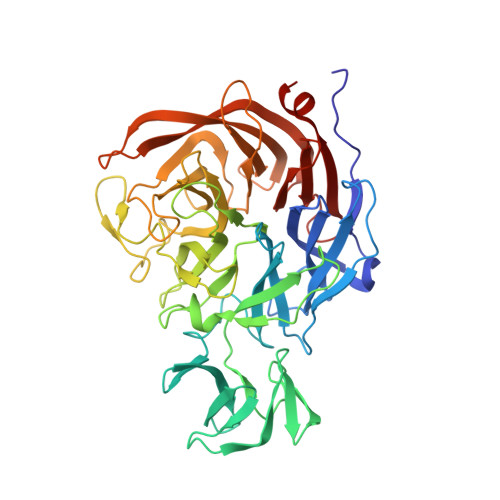The Structure of Clostridium Perfringens Nani Sialidase and its Catalytic Intermediates.
Newstead, S.L., Potter, J.A., Wilson, J.C., Xu, G., Chien, C.H., Watts, A.G., Withers, S.G., Taylor, G.L.(2008) J Biol Chem 283: 9080
- PubMed: 18218621
- DOI: https://doi.org/10.1074/jbc.M710247200
- Primary Citation of Related Structures:
2BF6, 2VK5, 2VK6, 2VK7 - PubMed Abstract:
Clostridium perfringens is a Gram-positive bacterium responsible for bacteremia, gas gangrene, and occasionally food poisoning. Its genome encodes three sialidases, nanH, nanI, and nanJ, that are involved in the removal of sialic acids from a variety of glycoconjugates and that play a role in bacterial nutrition and pathogenesis. Recent studies on trypanosomal (trans-) sialidases have suggested that catalysis in all sialidases may proceed via a covalent intermediate similar to that of other retaining glycosidases. Here we provide further evidence to support this suggestion by reporting the 0.97A resolution atomic structure of the catalytic domain of the C. perfringens NanI sialidase, and complexes with its substrate sialic acid (N-acetylneuramic acid) also to 0.97A resolution, with a transition-state analogue (2-deoxy-2,3-dehydro-N-acetylneuraminic acid) to 1.5A resolution, and with a covalent intermediate formed using a fluorinated sialic acid analogue to 1.2A resolution. Together, these structures provide high resolution snapshots along the catalytic pathway. The crystal structures suggested that NanI is able to hydrate 2-deoxy-2,3-dehydro-N-acetylneuraminic acid to N-acetylneuramic acid. This was confirmed by NMR, and a mechanism for this activity is suggested.
Organizational Affiliation:
Centre for Biomolecular Sciences, University of St. Andrews, St. Andrews, Fife, United Kingdom.

















